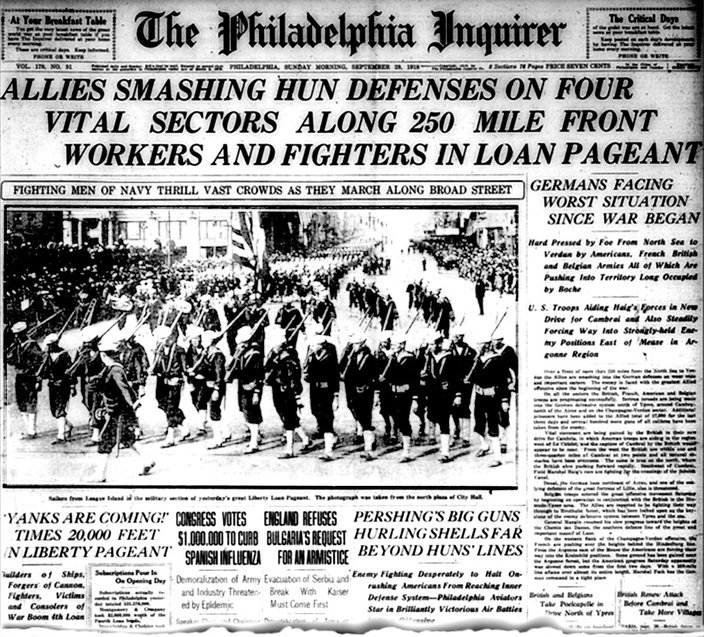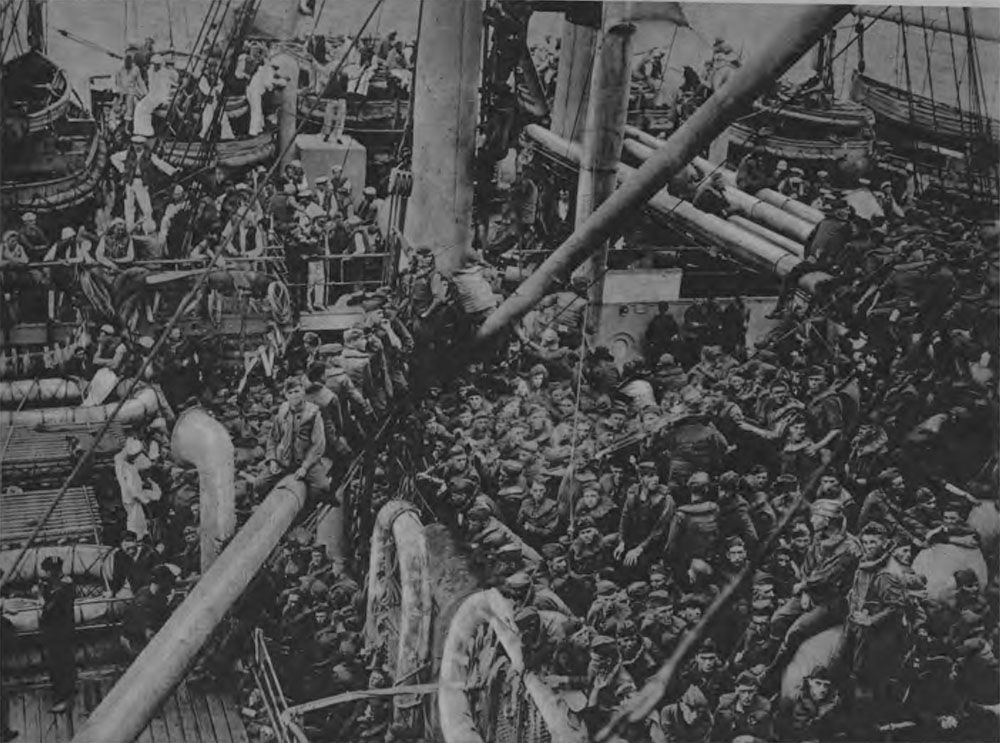
Take a quick breath to take stock.
Three weeks ago. Day 1, influenza begins at Fort Devens, Massachusetts. It’s back after an outbreak some three months before, in the spring, a seasonal thing.
Now, on Day 21, Saturday, September 28, 1918…
…a helluva day.
At 1am this morning Major Ernest Gibson and his military comrades were ordered into line and told to start marching from their quarters in Camp Merritt, New Jersey. A massive troop transport ship, the Leviathan, waits dockside, in port at Hoboken, New Jersey. Gibson and a few thousand other American soldiers will begin a trans-Atlantic journey to France to take part in the ongoing Meuse-Argonne offensive now three days old.
Within minutes, a problem. The Camp Merritt men haven’t take more than a few steps before Gibson sees “many men were falling out of ranks, unable to keep up.” Doctors rush to them, checking for influenza. Sure enough, they’ve got it. Gibson and those still capable of marching walk on. More men collapse during the march. Gibson and the rest walk on. Now on board the whale-like ship that has swallowed them up, another 100 sick men are carried off back to beds somewhere in Hoboken. Back in the belly, Gibson waits for tomorrow, the first day at sea, and France over the dark horizon.
Dr. William/Wilmer Krusen is up, awake, and later at his office in Philadelphia during Gibson’s horrific morning. Krusen has approved today’s Liberty Loan event—festival, really—in downtown Philadelphia. Thousands of people line Market Street and other avenues in the heart of the city. Hundreds of people participate in the parade, with marching groups of schoolchildren, soldiers, women, and workers representing every occupation imaginable. Very Important People give speeches, including Charles Schwab on the vital role and contribution to be made by each new bond-buyer, large and small, young and old. Military bands are everywhere, playing “The Yanks Are Coming” over and over and over again. Crowds sing the popular tune, written a year ago by George Cohen. The song is almost a mania. The festival is unlike anything residents of Philadelphia have seen before.
People standing shoulder-to-shoulder. Hugs, pats on the back, hand-holding, hand-shaking, arms for cradling small children, shoulders for lifting up small children for a better view, backs for carrying small children worn out from the day. People by the tens of thousands.
At Fort Devens, influenza’s ground-zero three weeks prior, an army doctor describes what he’s seen with the illness. “Two hours after admission they have the mahogony spots over the cheek bones,” the doctor writes, “and a few hours later you can begin to see the Cyanosis extending from their ears and spreading all over the face…It is only a matter of a few hours then until death comes, and it is simply a struggle for air until they suffocate. It is horrible.”
Though he doesn’t say it outright, the doctor attests to an incalculable emotional toll. “One can stand it to see one, two or twenty men die,” he asserts. “But to see these poor devils dropping out like flies sort of gets on your nerves.”
The doctor isn’t heartless or cruel. He is simply trying, struggling, and failing to capture the hellish world that is now his life and their lives, his survival and their deaths.
He finishes the description with data and analysis, firmer ground for him. “We have been averaging about 100 deaths per day, and still keeping it up. There is no doubt in my mind that there is a new mixed infection here, but what I don’t know.”
The ground is disturbed in Billings, Montana when a foot drives a shovel into the dirt. The shovel removes some soil, then again, again, again. More shovels and more soil. And now a machine eases a large, heavy stone into the broad, open hole. A speech is made. The cornerstone of the new St. Vincent Hospital is firmly in place. Let the rest of the building begin.
No cases of influenza have been seen yet in Billings.
A thought for you on Day 21, April 1, 2020, twenty-one days after President Trump declares Covid-19 a national emergency—the mistake. The people of Philadelphia participated in the unfolding of a mistake when the Liberty Loan event occurred as planned. Note my words here. They participated as an outcome or product of the mistake, they didn’t make the mistake themselves. The act of having allowed the event to go forward after numerous days of extensive illness in the city—that’s the mistake, the actual committing of the mistake. And for the source of the mistake we have to look to people in selected positions of power and authority up to September 29th. They did it, they made the mistake. The people will suffer effects and consequences of the mistake in the future. For now, in the present and in the day, we have to concentrate on the making and makers of the mistake. Their thinking proved no more nimble than the whale-like boat carrying Gibson and his mates into the sea. They sealed off the influence of key information. They kept other information prominent and dominant in their minds. From there, with the elevated and protected information now chosen, they then extrapolated, concluded, and assumed outcomes. They launched a fate that didn’t have to be wondered or guessed at. It was already around them. The last thing often changed is a closed mind. Hope that it is not too late.

(note to reader—I invite you to subscribe to this series/blog. The purpose of my posting in this series is the purpose of my enterprise at Historical Solutions—to explore the past in a new way that brings new and different value to you, both in the present (this minute) and on the edge of the future (what’s ahead or forward of this minute). The past is everything before now, the totality of all time before the present; history is a set of very small slices of the past that, for a particular reason, have been remembered. If you wish to contact me privately, please do not hesitate to text or call 317-407-3687)







